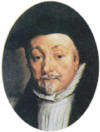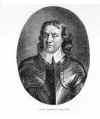|
Peaceful
co existence of the Presbyterians shattered.
Peaceful co
existence was shattered by the resurgence of the Bishops
seeking control. 1633 was a watershed in Ireland
with the appointment of William Laud as Archbishop
of Canterbury (picture right) and Thomas Wentworth, later the Earl of Strafford, as Lord Thomas Wentworth, later the Earl of Strafford, as Lord
Deputy in Ireland. Both these individuals became fierce
opponents of non conformists and Presbyterians in
particular. Laud had his differences of theology, but Wentworth, however, was brought up in a Puritan household and was of Calvinist sympathies. His character and his rule in Ireland was driven by his overriding desire to serve the king – loyalty to Charles was an absolute requirement of the populace and not a matter for debate. This drew him into conflict with the Presbyterians on the major point of principle that the king was not head of the Kirk. At the centre of the drama in Ulster were
Robert Blair and John Livingston who were suspended by
Bishop Echlin in 1632. Things came to a head in August
1636 when five of the ministers – Brice, Ridge,
Cunningham, Calvert and Hamilton were summoned before the
Bishop of Down and required to explain their refusal to
accept Episcopacy. They were unable in all conscience to
accept the Bishop`s rule and were sentenced to “perpetual
silence within this diocese.” Against this background the
Reverends John Livingston, Robert Blair and Robert
Cunningham had meanwhile been exploring the possibilities
of going to the Massachusetts colony and had set in motion
the building of the ship, the “Eaglewing
” But even here they were thwarted in 1636 by bad
weather and the migrants had to return to Ireland and a
growing persecution.
The bishops might silence his own ministers, but not the Presbyterians who did not recognise his authority in the first place. The ejected ministers stayed for a while in their parishes and held private meetings in convenient places endeavouring to be unobtrusive. But before long they had to resort to the conventicle, gathering in secluded places and among the hills. The commitment of the people to their minister is illustrated by the example of John Livingstone who became minister at Stranraer. While here members from his former congregation regularly made the sometimes stormy three hour boat trip from Donaghadee to be at his service. On one occasion over five hundred people came for a Communion and on another he baptised twenty eight children brought from Co.Down to Stranraer.
The Black
Oath
The people
themselves began to be persecuted for simply being
Presbyterian – a Mrs Pont, a ministers wife, was sent to
prison for three years. Lady Clotworthy was summoned
before a court to explain herself; Sir Robert Adair was
indicted for treason , lost all his property and had to
flee to Scotland; Henry Stewart a wealthy landowner was
fined a total of £16,000 – a huge amount of money at that
time.
The
Presbyterians were in 1639, subjected to the ` Black Oath` –
requiring a declaration of loyalty to the King and
denouncing all covenants including the National Covenant. Commissions were issued to all the northern magistrates who were required to administer it in their districts. It was publicly read to the people who were required to take the oath on their knees. Scots who professed they were Roman Catholics were exempted. But troops sent to compel Presbyterians to swear the oath did their duty with excessive and ruthless brutality. This was followed up by Episcopalian ministers and church
wardens having to produce a return of all Presbyterians in
their vicinity and whether they had taken the Oath. There
followed many imprisonments and people began seeking
refuge in the forests and caves and fleeing to
 Scotland. Scotland.
Wentworth, now Earl of Strafford, and Lord
Lieutenant of Ireland even began his plan to banish all
Presbyterians from the country. A list was produced of the
leading Presbyterians, ministers and people, who were
ordered to remove themselves to the Province of
Munster – the counties of Kilkenny, Waterford and
Tipperary.
Providence
intervened, as King Charles had been defeated in a battle
by the Scots in the North East of England and had to call
a meeting of Parliament to obtain funds to continue the
war. This ` Long Parliament` as it was to be called
impeached Wentworth for his misdeeds and consigned him to
the headsman`s axe in May 1641. In the same year there
began the Irish Killing
Time as the native Irish sought to regain the
escheated lands, and began their murderous onslaught on
the Protestant settlers.
The
Representation
The Solemn
League and Covenant of 1643 was the agreement by
Presbyterians and the English Parliamentarians for military support, but
importantly, included the
extension of the Presbyterian faith into England, Ireland
and Wales. It was taken to Ireland by the Rev James
Hamilton in 1644, widely disseminated and sworn to with
enthusiasm by the people. A consequence of this was a
growth in the demand for ministers, their number rising to
over 30 by 1647.
Yet again
the Presbyterian conscience was troubled both by the way a
majority in Parliament was achieved ( by locking up
dissenting Members so they couldn`t vote ) and by the
decision to execute King Charles in January 1649 . On 15
February 1649 the Presbytery met in Belfast and drew up a
` Representation` objecting to the Kings death which was
ordered to be read from every pulpit. This understandably
soured relationships with the English Parliamentarians who
commissioned no less a person than John Milton to respond
to it. Milton denounced the Presbytery and its
Remonstrance as “devilish malice, impudence and falsehood
” and called Belfast ” a barbarous nook of
Ireland “. But true to their beliefs the Presbyterians
continued to protest against the conduct of the
Parliamentarians and denounced them as usurpers. There
soon followed the landing of Oliver Cromwell at
Dublin on 15 August 1649, and his swift campaign to subdue
Ireland.
The
Engagement in Ireland
There were
two agreements entitled ” The Engagement ” the first being
in 1647 between Charles I and Scottish nobles, led by the Duke of Hamilton, in which the
King agreed to the Solemn League and Covenant and
Presbyterianism faith allowed for three years after which
a definite settlement was to be made. On the other hand
the Covenant was not to be forced on anyone who did not
want to subscribe and in the Royal Household
Episcopal worship would remain. But the Scottish General
Assembly never approved the agreement, and after the
defeat of the “Engagers” at Preston by Cromwell`s forces, power returned to the strict Covenanters who established a period of Kirk rule in Scotland.
However.
arising from Cromwell`s subjugation in Ireland, there was another oath, also
called ” The Engagement ” which renounced the claim of
Charles Stuart, the

heredity claims of King Charles line, and bound
signatories to be true and faithful to the Commonwealth,
as Cromwell`s government was known. Some of the Irish
Presbyterians refused to take the oath and were subject of
more severe punishments with very many fleeing to Scotland
. Only a handful of ministers remained in Ireland
ministering to their flocks through the `conventicle` –
the clandestine open air meeting. Some of the vacant ministries
were filled by other non conformist ministers from England
and plans were put in train to banish the leading
Presbyterians from counties Antrim and Down. The
government proposal in 1652-3 was to remove some leading
Presbyterians to Munster with the promise of cheap land
and ` freedom of conscience`. To an extent the
Presbyterians identified were reluctant but also
acquiescent to an obviously superior force, and negotiated
the best terms they could get, including the timing so as
to be able to obtain the benefit of crops they would
otherwise have to leave waste.
At one point Cromwell invited the Independents / Puritans of New England to come to Ireland where he wished their influence to be paramount. But they were very careful to make conditions including retention of the freedoms they currently enjoyed; they were to be provided with house and lands in a healthy part of the country; their people could come with them; be able to elect their own Governor and to be exempt of taxes for several years. These worldly demands contrast greatly with the Presbyterian ministers who
“were not in the priesthood for a morsel of bread. When their incomes were suddenly removed , they lived hardily and scantily, and ceased not, while free, by night and day, to ride over large areas to perform the duties of their calling for their scattered flocks.”
Perhaps the demands of these Independents, and an economic pragmatism, helped Cromwell to realise that although dissenters, the
Presbyterians were essentially law abiding and would not
otherwise give him much trouble; so discrimination ceased. The banished and excluded ministers were allowed to return with full freedom to preach. Cromwell
also saw the opportunity to plant a protestant population
in Munster and Leinster by banishing priests and forcing
Catholic land owners to move to Connaught. The seized land
was then used to pay his soldiers, although many then
quickly sold their allotted land on to whomsoever wanted
it.
In May 1655
Col. Barrow, Col. Trayle and Mr Timothy Taylor, minister
at Carrickfergus, were appointed to produce a list
of names of persons qualified to preach the Gospel. In
November of that year Col. Trayle made a return of
Scottish ministers in the Province and some fourteen
were recipients of an allowance of £50 on 25 December and
25th March following. On 13 May 1656 their names were
added to the Civil List with their appointments.
James
Gordon (Comber) John Drisdaile (Portaferry)
Patrick Adair (Carncastle
Garden) Robert Cunningham (Braid)
John Gregg
(Newtown) Gilbert Ramsay (Bangor)
Thomas Peebles (Kirkdonnell) William Richardson (Killileagh)
Andrew Steward (Donaghadee) Gabriel Cornwall (Balliwoolen)
Thomas Hall
(Larne) Gilbert Simpson (Ballyclare)
William McCormick (Magheralin) William Jack (Aghadowey)
Donald Richmond (Hollywood).
Subsequently all ministers who applied received an
endowment of around £100. There were soon five
Presbyteries with some eighty congregations under seventy
ministers ruled by a General Synod which met four times a
year. But Oliver Cromwell died in September 1658 and his son, Richard, failed to hold the Republican Commonwealth together. The door was
reopened to another time of repression through the
duplicity of King Charles II who reneged on his acceptance
of Presbyterianism and the National Covenant.
Next:
The
Restoration of Charles II in 1660, and after.
18/07/2011
|